Today, our discussion is all about the world of low-intensity workouts tailored just for seniors. We know that staying active as we age is crucial for our overall health and well-being.
That’s why we’re here to explore the best exercises that are gentle on your body but mighty in their benefits. These exercises usually reduce strain on your joints, improve muscle strength, flexibility, and balance, all while lower the risk of injury.
From calming swims to invigorating walks and the tranquillity of yoga, we’ve got you covered. Whether you’re easing into fitness or maintaining your active lifestyle, these workouts are customizable and accessible, so you can find what suits you best.
But before we jump in, let’s learn why this type of exercise is good for seniors. Also, we’ll discuss the safety features so that you will have no issues while performing these exercises.
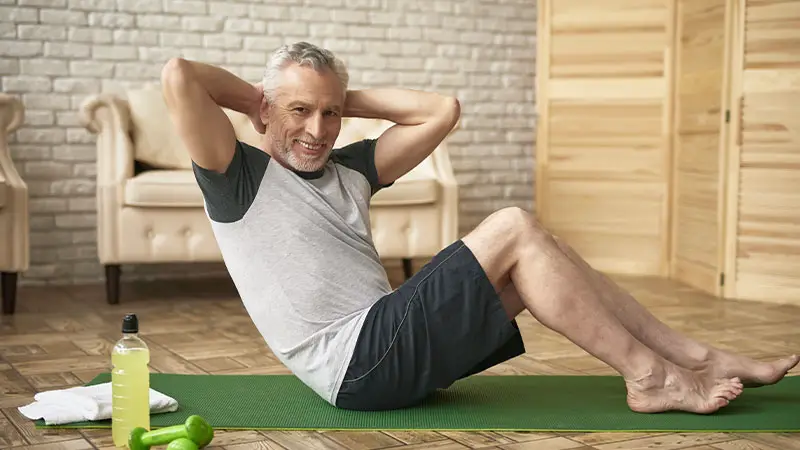
Why Low intensity Workouts Are Suitable for Seniors?
Low-intensity workouts are like a gentle breeze blowing through your life, offering a multitude of benefits tailored just for you. Here’s why they’re so perfect for seniors like us:
Reduced Strain on Joints
These exercises, like walking, swimming, and yoga, are like a soothing balm for our joints. They’re gentle, easing any discomfort or pain we might have, especially if we’re dealing with arthritis or joint issues.
Muscle Strengthening and Flexibility
Picture this: every stretch, every movement is like giving your muscles a warm hug. These workouts not only make our muscles stronger but also keep them flexible, helping us move more freely and with confidence.
Lower Risk of Injury
Ah, safety first! With low-intensity exercises, we’re steering clear of any unnecessary risks. No strains, no sprains – just smooth sailing towards better health.
Health Benefits Galore
These workouts are like a secret potion for our bodies. Improved heart health, better sleep, a boosted immune system – they’re all part of the package! Plus, they do wonders for our mental well-being, keeping us sharp and happy.
Customizable and Accessible
One size doesn’t fit all, right? That’s why these workouts can be tailored to suit our needs perfectly. Whether we prefer to exercise at home or in a group, there’s something for everyone.
Affordability and Minimal Equipment
No need for fancy gadgets or expensive gear. Just a willingness to move and maybe a few household items like cans of soup for added resistance!
So, you see, low-intensity workouts are like the gentle rhythm of life, steady, comforting, and oh-so-beneficial. They’re not just exercises; they’re our partners in staying strong, healthy, and happy as we journey through the golden years.
10 Best Low intensity Workouts for Senior
Now, let’s learn about the 10 best low intensity workouts for seniors. Here I will show you why these exercises are essential and how you should perform them:
1. Swimming: Embrace the Gentle Flow
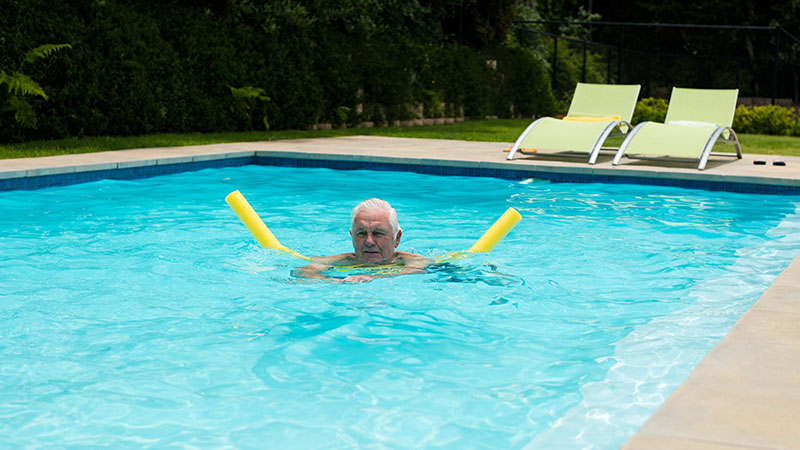
Swimming is like a dance with the water, offering a low-impact and no-impact workout that’s incredibly gentle on the joints. It provides a full-body workout while reducing the risk of strain or injury, making it perfect for seniors.
Moreover, the buoyancy of water supports our body weight, alleviating pressure on our joints and allowing for smooth movements. Plus, it’s an excellent cardiovascular exercise that improves heart health and enhances lung capacity.
How to Try It:
- Start with simple strokes like freestyle or breaststroke.
- Gradually increase your swimming duration and intensity as you build confidence.
- Don’t forget to warm up before diving in and cool down afterward with some gentle stretches in the water.
2. Walking: Step Into Better Health
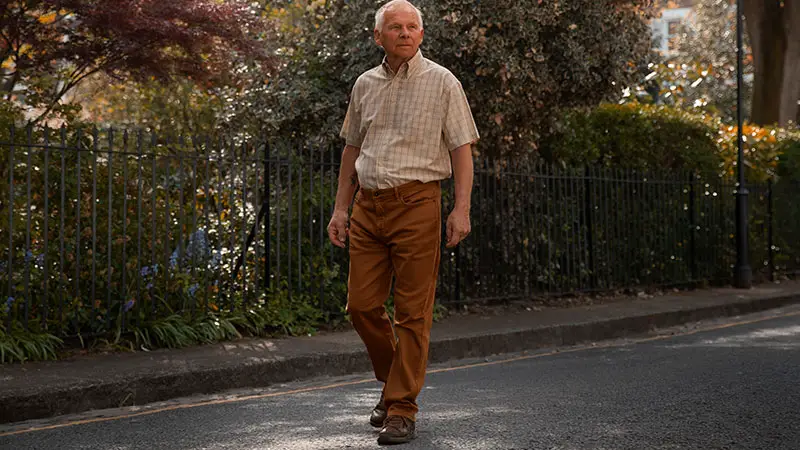
Walking is a simple yet powerful aerobic exercise that’s gentle on the body and good for overall conditioning. It strengthens muscles, boosts cardiovascular health, and improves mood, making it perfect for seniors looking to stay active.
Moreover, it’s easily accessible and can be done virtually anywhere, whether it’s a stroll in the park or a brisk walk around the neighbourhood.
How to Try It:
- Start with short walks at a comfortable pace, gradually increasing your distance and speed.
- Focus on maintaining good posture and swinging your arms gently as you walk.
- Don’t forget to wear supportive footwear and stay hydrated during your walks.
3. Yoga: Find Balance and Harmony

Yoga is a beautiful blend of movement, breath, and mindfulness, offering numerous benefits for seniors. It improves flexibility, strengthens muscles, enhances balance, and promotes relaxation.
Additionally, yoga can help alleviate common age-related issues like arthritis pain and stiffness, making it an ideal practice for seniors seeking holistic well-being.
How to Try It:
- Start with beginner-friendly poses like Mountain Pose, Chair Pose, and Cat-Cow Stretch.
- Focus on breathing deeply and mindfully throughout your practice.
- Use props like blocks and straps to support your body and prevent strain.
4. Sitting Exercises: Stay Active, Stay Seated
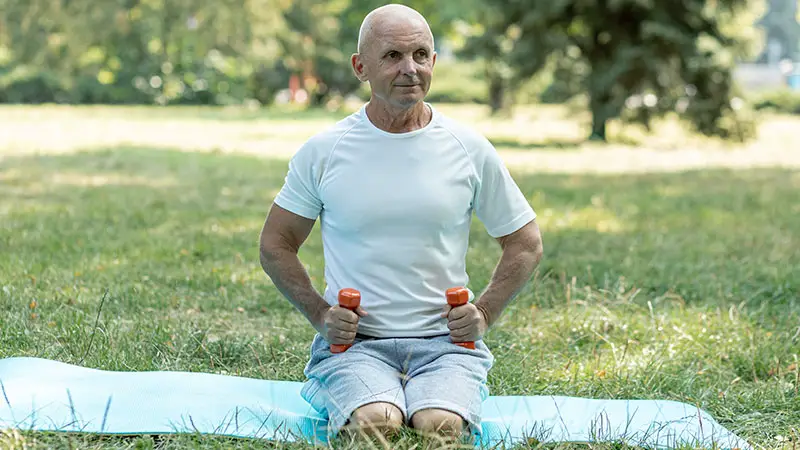
Sitting exercises are perfect for seniors with mobility issues or those who prefer a seated workout. They help build strength, improve circulation, and keep joints lubricated and mobile.
Additionally, sitting exercises can be easily modified to accommodate individual fitness levels and limitations, making them accessible to everyone.
How to Try It:
- Start with simple seated movements like arm circles, leg lifts, and seated twists.
- Use a sturdy chair with armrests for added stability and support.
- Focus on maintaining proper posture and engaging your core muscles throughout the exercises.
5. Strengthening Exercises: Build Strength, Build Confidence
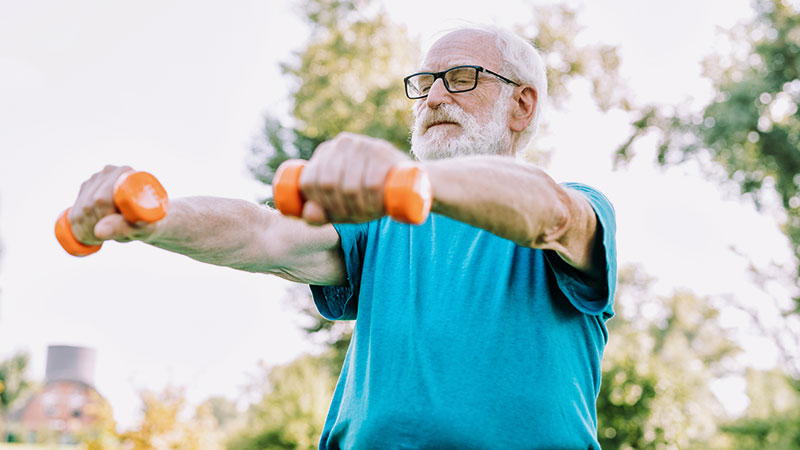
Strengthening exercises, whether using weights, resistance bands, or household items, are essential for seniors to maintain muscle mass and bone density.
They improve overall strength, enhance mobility, and reduce the risk of falls and fractures. Moreover, strength training can help alleviate symptoms of chronic conditions like arthritis and osteoporosis, promoting better quality of life.
How to Try It:
- Start with light weights or resistance bands and gradually increase the resistance as you get stronger.
- Focus on compound exercises that target multiple muscle groups, such as squats, lunges, and bicep curls.
- Don’t forget to warm up before strength training and cool down with some gentle stretches afterward.
6. Body Weight Workouts: Strength in Simplicity
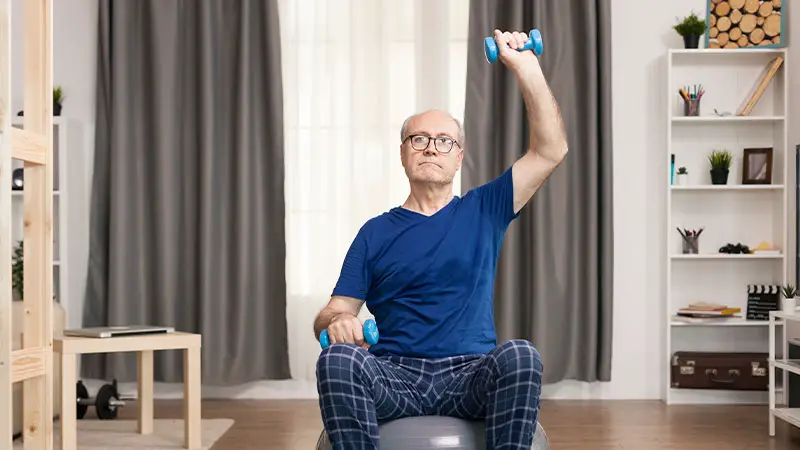
Bodyweight workouts are incredibly versatile and effective for seniors, requiring minimal equipment and space.
They help improve strength, balance, and flexibility without putting undue stress on the joints. Plus, they can be easily modified to suit individual fitness levels and goals, making them accessible to seniors of all abilities.
How to Try It:
- Start with basic bodyweight exercises like squats, lunges, push-ups, and planks.
- Focus on performing each exercise with proper form and control.
- Gradually increase the number of repetitions or difficulty of the exercises as you progress.
7. Dumbbell Strength Training: Lift, Strengthen, Thrive
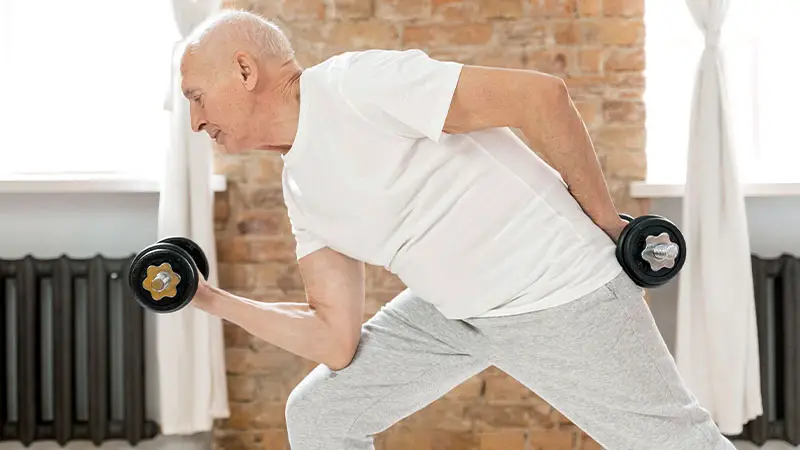
Dumbbell strength training offers seniors a convenient way to build muscle, improve bone density, and boost metabolism. It helps increase overall strength and functional fitness, making daily tasks easier and reducing the risk of injury.
Additionally, strength training with dumbbells can enhance glucose control, benefiting seniors with conditions like diabetes.
How to Try It:
- Start with light dumbbells and focus on proper form and technique.
- Choose exercises that target major muscle groups, such as chest presses, shoulder raises, and tricep extensions.
- Gradually increase the weight and intensity of your workouts as you become stronger.
8. Resistance Band Workouts: Stretch, Strengthen, Succeed
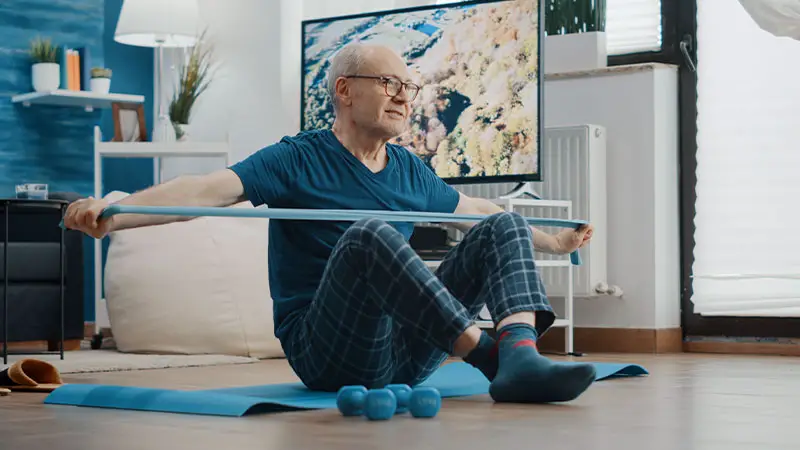
Resistance band workouts are a fantastic option for seniors looking to improve strength, flexibility, and balance. The bands provide gentle resistance, making them safe and effective for older adults.
They’re also versatile and portable, allowing for workouts anywhere, anytime. Plus, resistance band exercises can help improve posture and reduce the risk of falls.
How to Try It:
- Start with light resistance bands and gradually increase the resistance as you get stronger.
- Focus on performing controlled movements with proper form.
- Incorporate a variety of exercises targeting different muscle groups for a balanced workout.
9. Pilates: Align, Strengthen, Energise
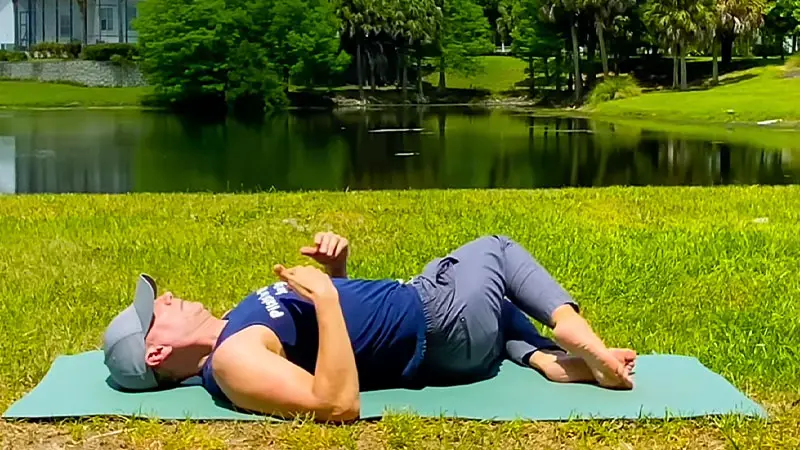
Pilates focuses on core strength, flexibility, and body awareness, making it an excellent choice for seniors seeking improved balance and stability. It helps alleviate back pain, improve posture, and enhance overall functional fitness.
Additionally, Pilates can be adapted to accommodate individual needs and limitations, making it accessible to seniors of all levels.
How to Try It:
- Start with beginner-friendly Pilates exercises like the Hundred, Roll-Up, and Leg Circles.
- Focus on breathing deeply and engaging your core muscles throughout each movement.
- Use props like foam rollers or Pilates rings to add variety and challenge to your workouts.
10. Balance Activities: Stay Steady, Stay Strong
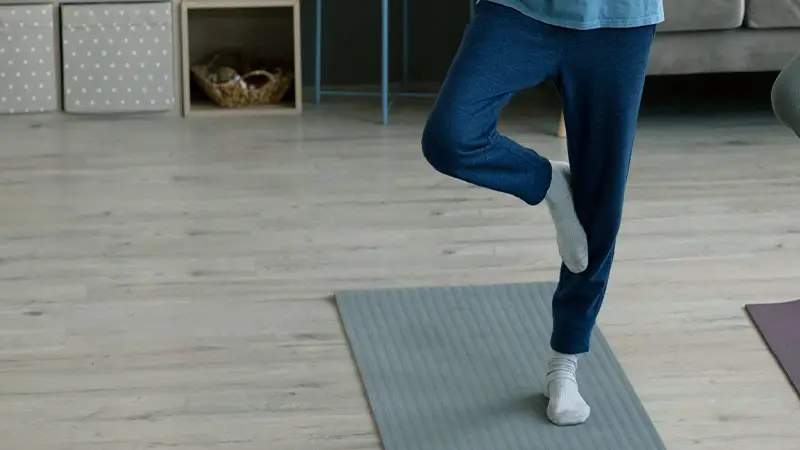
Balance activities are essential for seniors to maintain stability, prevent falls, and improve overall confidence in movement. They help strengthen core muscles, improve proprioception, and enhance coordination.
Additionally, balance exercises can be easily incorporated into daily routines, making them accessible and practical for seniors.
How to Try It:
- Start with simple balance exercises like standing on one leg or walking heel-to-toe.
- Use props like a wobble board or stability ball to add challenge and variety to your workouts.
- Practice balance activities regularly to see improvements in stability and confidence over time.
These ten low-intensity workouts offer seniors a variety of options to stay active, healthy, and independent.
Whether you prefer the gentle flow of swimming, the mindful movement of yoga, or the strength-building benefits of resistance training, there’s something for everyone.
Just remember to listen to your body, start slowly, and enjoy the journey to better health and well-being!
Wait! Be Careful of These Facts While Trying Low intensity Workouts
As we learn about the most effective low-intensity workouts, it’s crucial to prioritise safety to ensure a positive and injury-free exercise experience.
Here are some important factors to consider:
Proper Warm-Up
Always begin with a thorough warm-up routine to prepare your body for physical activity. This helps increase blood flow to your muscles, improve flexibility, and reduce the risk of injury.
Gradual Progression
Avoid the temptation to push yourself too hard, too fast. Instead, start at a manageable pace and gradually increase the frequency, intensity, and duration of your workouts as your strength and endurance improve.
Equipment Familiarisation
If using any equipment or props during your workouts, take the time to familiarise yourself with them beforehand. Improper use or unfamiliarity with equipment can increase the risk of injury.
Maintain Correct Form
Focus on maintaining proper form and technique throughout your exercises. This not only ensures you’re targeting the right muscles but also helps prevent injuries caused by incorrect movements.
Stay Hydrated
Dehydration can occur during low-intensity workouts, especially in activities like swimming or yoga where you may not feel as thirsty. Remember to drink plenty of water before, during, and after your workouts to stay hydrated and prevent fatigue.
Listen to Your Body
You should pay attention to any signals or discomfort your body may be sending you. If you experience pain, dizziness, or excessive fatigue, it’s important to stop and rest. Pushing through discomfort can lead to injuries and setbacks.
Rest and Recovery
Make sure to allow your body time to rest and recover between workouts. Overtraining can increase the risk of injury and fatigue, so listen to your body’s cues and give yourself permission to take breaks when needed.
Cross Training
Incorporating a variety of exercises into your routine can help prevent overuse injuries and keep your workouts fresh and enjoyable. Mix up your low-intensity workouts with different activities to challenge your body in new ways.
By being mindful of these factors and prioritising safety in your low-intensity workout routine, you can enjoy all the benefits of staying active while minimising the risk of injury. Remember, your health and well-being are always the top priority!
Wrapping Up
Regularly performing low-intensity workouts offers seniors a pathway to enhanced health, vitality, and overall well-being.
From the serene waters of swimming to the mindful practice of yoga, these gentle exercises cater to diverse preferences and abilities, ensuring inclusivity and accessibility for all.
By prioritising safety, gradually progressing, and listening to our bodies, we can embark on a journey of fitness that enriches both our physical and mental health.
Remember, the benefits extend far beyond the physical realm, from improved cardiovascular health to enhanced balance and flexibility, and even to a boosted mood and sharper mind.
As we navigate the golden years, these workouts become our steadfast companions, empowering us to stay active, independent, and thriving.
So, whether you’re stepping into the pool, rolling out your yoga mat, or simply taking a stroll in the park, know that each movement brings you closer to a life filled with vitality and joy.
I am a fitness instructor and I have been in the industry for 9 years. I have a passion for health and fitness.
I am a fitness instructor with over 9 years of experience in the industry. My passion is health and fitness and I would love to share my knowledge with you!